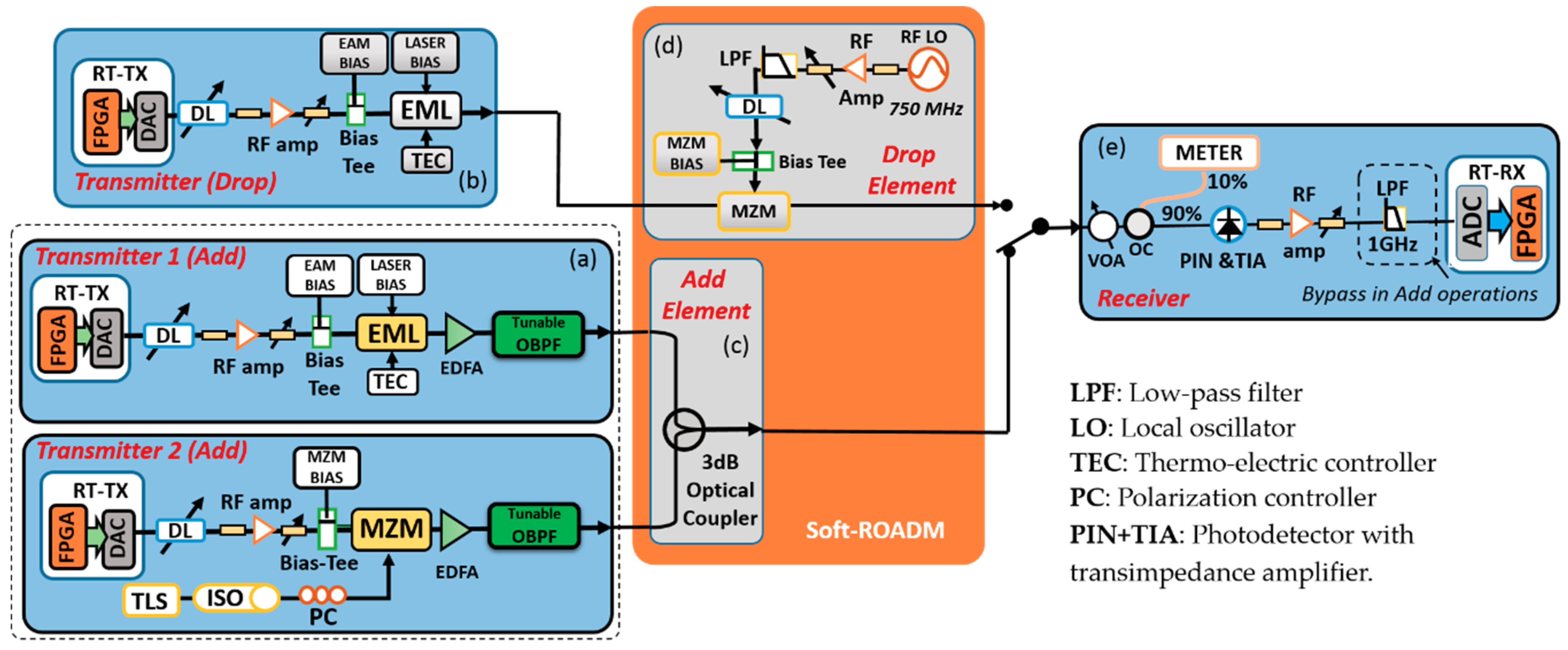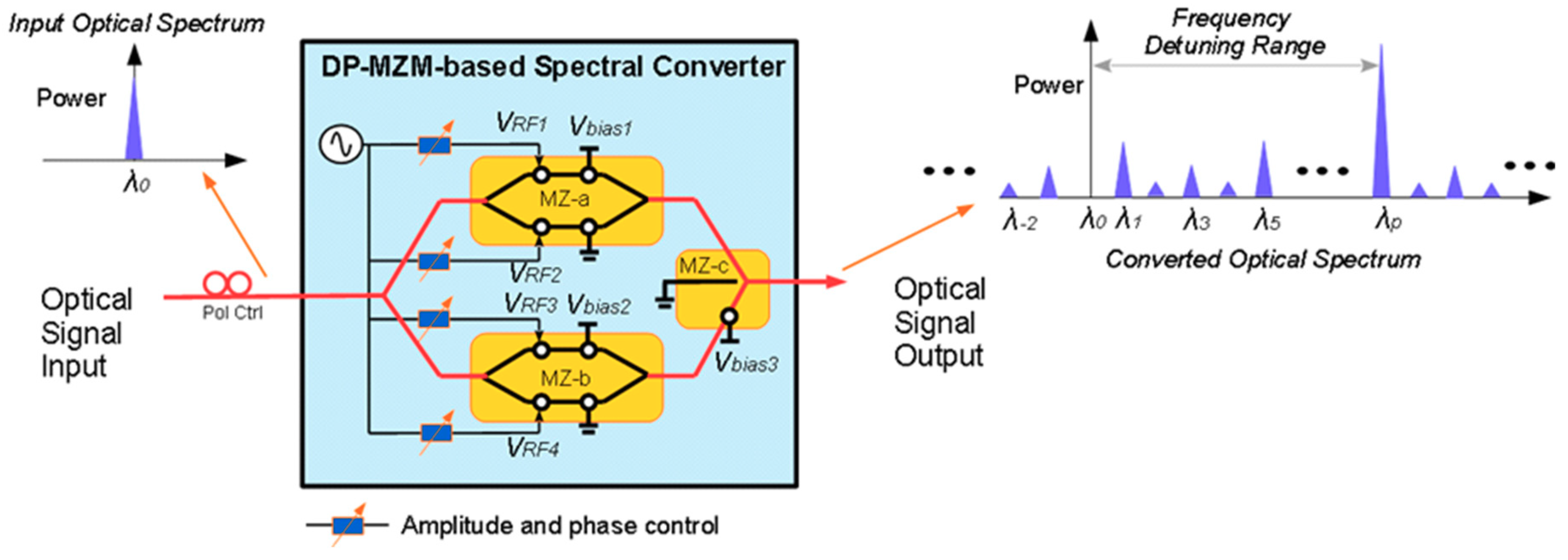A Review of DSP-Based Enabling Technologies for Cloud Access Networks
Abstract
:1. Introduction
2. Cloud Access Network Concept
2.1. Overview
- Seamless integration of Metro-networks, fixed access networks, and 4G/5G fronthaul and backhaul networks.
- Provision of a sliceable and dynamically reconfigurable network which can efficiently support virtualised networks at sub-wavelength connectivity levels with elastic bandwidth provision.
- Full support of SDN for efficient control and management of the network configuration, with control extended to the physical layer.
- Support of DSP-based advanced modulation formats to achieve spectrally efficient high-speed interconnections.
- Channel transparency to underlying signal characteristics, such as bandwidth and modulation format.
- Excellent backwards compatibility with existing optical transmission technologies as the baseband region in the optical domain can be allocated to existing TDM-based optical signals.
- Dynamically reconfigurable and highly flexible network elements.
- Exploitation of existing passive optical network (PON) infrastructures by the use of advanced multiple access techniques.
- Enhanced physical layer data security the as full details of the channel multiplexing parameters are required to perform data recovery.
- An inherent “pay as you grow” network operation model, as the growing demand for aggregate capacity can be met by adding additional channels to the network as required.
2.2. Digital Orthogonal Filtering-Based Channel Multiplexing
2.3. CAN Architecture
- They form the link terminations and are the only points at which optical-electrical (OE) and electrical-optical (EO) conversion occurs.
- They incorporate the embedded DSP which realises the digital orthogonal filtering-based channel multiplexing.
- The only point at which signals are modulated and demodulated as the CAN is transparent to signal modulation formats.
- Provide variably/adaptively modulated signals with variable bandwidth located within the digital orthogonal filtering space.
- Support SDN control via a centralised SDN controller, to manage channel allocation and avoid possible channel contention.
- Operation completely in the optical domain, thus avoiding the need for OE and EO conversions.
- Supports WDM-multiplexed optical signals.
- Channel add/drop functions operating at the wavelength, sub-wavelength and orthogonal sub-band levels.
- Provides connectivity to one or more PONs with dynamically variable capacity.
- Provision of mobile backhaul links to BBUs with dynamically variable capacity.
- Provision of mobile fronthaul links between BBUs and RRHs at different locations in the CAN and with dynamically variable capacity.
- Transparent to the underlying signal modulation formats.
- Fully compatible with SDN-based network control.
- Virtually negligible latency for compliance with the ultra-low latency 5G requirements.
- Low complexity and thus low cost due to no OE or EO converters or extra light sources.
- Virtually no distortion to the converted signal waveform.
- Strict transparency to the underlying signal characteristics.
- SDN-controllable reconfigurability of parameters, such as conversion efficiency, and frequency detuning range.
- The utilisation of optical bandwidth outside the operating range of the ROTs.
- Conversion-induced latency is negligible.
3. CAN Network Elements
3.1. Reconfigurable Optical Transceivers
3.1.1. Operating Principle and Design Aspects
3.1.2. DSP Architecture and Real-Time Experimental Demonstrations
3.2. Soft-ROADMs
3.2.1. Operating Principle
3.2.2. Soft-ROADM Experimental Demonstrations
3.3. Spectral Converters
3.3.1. Functionality and Operating Principle
3.3.2. Experimental Analysis of Spectral Converter Performance
4. Conclusions
Author Contributions
Funding
Conflicts of Interest
References
- Dubey, N. From Static Networks to Software-driven Networks—An Evolution in Process. Available online: http://www.isaca.org/Journal/archives/2016/volume-4/Pages/from-static-networks-to-software-driven-networks-an-evolution-in-process.aspx (accessed on 14 November 2018).
- Ibe, O.C. Fundamentals of Data Communication Networks; Wiley: Hoboken, NJ, USA, 2017; ISBN 9781119436270. [Google Scholar]
- Predictions 2016: The Dawn of the Gigabit Internet Age: Every Bit Counts | Technology, Media, and Telecommunications. Available online: https://www2.deloitte.com/il/en/pages/technology-media-and-telecommunications/articles/tmt-pred16-telecomm-dawn-of-the-gigabit-internet-age.html (accessed on 27 September 2018).
- Zilberman, N.; Watts, P.M.; Rotsos, C.; Moore, A.W. Reconfigurable Network Systems and Software-Defined Networking. Proc. IEEE 2015, 103, 1102–1124. [Google Scholar] [CrossRef]
- Amin, R.; Reisslein, M.; Shah, N. Hybrid SDN Networks: A Survey of Existing Approaches. IEEE Commun. Surv. Tutor. 2018. [Google Scholar] [CrossRef]
- Duan, X.; Giddings, R.P.; Mansoor, S.; Tang, J.M. Experimental demonstration of upstream transmission in digital filter multiple access pons with real-time reconfigurable optical network units. J. Opt. Commun. Netw. 2017, 9, 45–52. [Google Scholar] [CrossRef]
- Jin, W.; Zhang, C.; Duan, X.; Kadhum, M.R.; Dong, Y.X.; Giddings, R.P.; Jiang, N.; Qiu, K.; Tang, J.M. Improved Performance Robustness of DSP-Enabled Flexible ROADMs Free from Optical Filters and O-E-O Conversions. J. Opt. Commun. Netw. 2016, 8, 521–529. [Google Scholar] [CrossRef]
- Bolea, M.; Giddings, R.P.; Tang, J.M. Digital Orthogonal Filter-Enabled Optical OFDM Channel Multiplexing for Software-Reconfigurable Elastic PONs. J. Light. Technol. 2014, 32, 1200–1206. [Google Scholar] [CrossRef]
- Bolea, M.; Giddings, R.P.; Bouich, M.; Aupetit-Berthelemot, C.; Tang, J.M. Digital filter multiple access PONs with DSP-enabled software reconfigurability. J. Opt. Commun. Netw. 2015, 7, 215–222. [Google Scholar] [CrossRef]
- Duan, X.; Giddings, R.; Bolea, M.; Ling, Y.; Mansoor, S.P.; Tang, J.M. Real-time Demonstrations of Software Reconfigurable Optical OFDM Transceivers Utilising DSP-based Digital Orthogonal Filters for Channel Multiplexing. In Proceedings of the Asia Communications and Photonics Conference ACP2014, Shanghai, China, 11–14 November 2014. [Google Scholar]
- Mao, M.Z.; Giddings, R.P.; Cao, B.Y.; Xu, Y.T.; Wang, M.; Tang, J.M. DSP-enabled reconfigurable and transparent spectral converters for converging optical and mobile fronthaul/backhaul networks. Opt. Express 2017, 25, 13836. [Google Scholar] [CrossRef] [PubMed]
- Yoo, S.J.B.; Caneau, C.; Bhat, R.; Koza, M.A.; Rajhel, A.; Ringo, J. Progress in wavelength conversion by difference-frequency generation in AlGaAs waveguides. In Proceedings of the 1997 Digest of the IEEE/LEOS Summer Topical Meeting: Vertical-Cavity Lasers/Technologies for a Global Information Infrastructure/WDM Components Technology/Advanced Semiconductor Lasers and Applications/Gallium Nitride Materials, Processing, and Devices, Montreal, QC, Canada, 11–13 August 1997; pp. 36–37. [Google Scholar]
- Nguyen, A.; Porzi, C.; Serafino, G.; Fresi, F.; Contestabile, G.; Bogoni, A. All-Optical Gated Wavelength Converter-Eraser Using a Single SOA-MZI. IEEE Photonics Technol. Lett. 2011, 23, 1621–1623. [Google Scholar] [CrossRef]
- Dorward, R.M.; Anderson, M.J.; Giddings, R.P. Technical and market feasibility of high-speed software-reconfigurable OOFDM/DFMA-based Optical transceivers for Next Generation Access Network PONs. In Proceedings of the International Conference on Transparent Optical Networks, Trento, Italy, 10–14 July 2016. Paper Th.B1.4. [Google Scholar]
- Al-Rawachy, E.; Giddings, R.P.; Tang, J.M. Experimental demonstration of real-time add/drop operations in DSP-enabled flexible ROADMs for converging fixed and mobile networks. In Proceedings of the Optical Fiber Communication Conference (OFC), San Diego, CA, USA, 11–15 March 2018. Paper W2A.33. [Google Scholar]
- Duan, X.; Giddings, R.P.; Mansoor, S.; Tang, J.M. Performance Tolerance of IMDD DFMA PONs to Channel Frequency Response Roll-off. IEEE Photonics Technol. Lett. 2017, 29, 1655–1658. [Google Scholar] [CrossRef]
- Giddings, R.P.; Jin, X.Q.; Hugues-Salas, E.; Giacoumidis, E.; Wei, J.L.; Tang, J.M. Experimental demonstration of a record high 11.25 Gb/s real-time optical OFDM transceiver supporting 25 km SMF end-to-end transmission in simple IMDD systems. Opt. Express 2010, 18, 5541–5555. [Google Scholar] [CrossRef] [PubMed]
- Giddings, R.P.; Hugues-Salas, E.; Tang, J.M. Experimental demonstration of record high 19.125 Gb/s real-time end-to-end dual-band optical OFDM transmission over 25 km SMF in a simple EML-based IMDD system. Opt. Express 2012, 20, 20666–20679. [Google Scholar] [CrossRef] [PubMed]
- Jin, X.Q.; Wei, J.L.; Giddings, R.P.; Tang, J.M.; Quinlan, T.; Walker, S. Experimental Demonstrations and Extensive Comparisons of End-to-End Real-Time Optical OFDM Transceivers With Adaptive Bit and/or Power Loading. IEEE Photonics J. 2011, 3, 500–511. [Google Scholar] [CrossRef]
- Duan, X.; Giddings, R.P.; Bolea, M.; Ling, Y.; Cao, B.; Mansoor, S.; Tang, J.M. Real-time experimental demonstrations of software reconfigurable optical OFDM transceivers utilizing DSP-based digital orthogonal filters for SDN PONs. Opt. Express 2014, 22, 19674–19685. [Google Scholar] [CrossRef] [PubMed]
- Al-Rawachy, E.; Giddings, R.P.; Tang, J.M. Experimental demonstration of a DSP-based cross-channel interference cancellation technique for application in digital filter multiple access PONs. Opt. Express 2017, 25, 3850. [Google Scholar] [CrossRef] [PubMed]
- Jin, W.; Duan, X.; Dong, Y.; Cao, B.; Giddings, R.P.; Zhang, C.; Qiu, K.; Tang, J.M. DSP-Enabled Flexible ROADMs Without Optical Filters and O-E-O Conversions. J. Light. Technol. 2015, 33, 4124–4131. [Google Scholar] [CrossRef]
- Jin, X.Q.; Groenewald, J.; Hugues-Salas, E.; Giddings, R.P.; Tang, J.M. Upstream power budgets of IMDD optical OFDMA PONs incorporating RSOA intensity modulator-based colorless onus. J. Light. Technol. 2013, 31, 1914–1920. [Google Scholar] [CrossRef]
- Cvijetic, N. Software-defined optical access networks for multiple broadband access solutions. In Proceedings of the Opto-Electronics and Communications Conference (OECC), Kyoto, Japan, 30 June–4 July 2013. Paper TuP2-1. [Google Scholar]
- Cvijetic, K.S.N.; Tanaka, A.; Ji, P.N.; Murakami, S.; Wang, T. First OpenFlow-based software-defined λ-Flow architecture for flex-grid OFDMA mobile backhaul over passive optical networks with filterless direct detection ONUs. In Proceedings of the Optical Fiber Communication Conference (OFC), Anaheim, CA, USA, 17–21 March 2013. Paper PDP5B.2. [Google Scholar]













| Parameter | Value | Parameter | Value |
|---|---|---|---|
| Total no. of IFFT/FFT points per channel | 32 | Total samples per symbol | 40 samples (20 ns) # |
| Data-carrying subcarriers per channel | 15 maximum | Error count period | 88,500 symbols |
| n-th subcarrier frequency | n × 31.25 MHz | EML laser wavelength | 1550 nm |
| Adaptive modulation formats | 16/32/64-QAM | 3 dB EML modulation bandwidth | 10 GHz |
| DAC and ADC sample rate/resolution | 2 GS/s/8 bits | Laser bias current | 124 mA |
| Symbol rate | 50 MHz | EAM bias voltage/driving voltage | −0.7 VDC/320 mVpp |
| Samples per symbol (IFFT) | 32 samples (16 ns) # | PIN detector bandwidth | 12.4 GHz |
| Cyclic prefix | 8 samples (4 ns) # | PIN detector sensitivity | −19 dBm * |
| Parameter | Value |
|---|---|
| add/drop data-carrying subcarriers per sub-band | 6/7 |
| OFDM modulation format | 16-QAM |
| DAC and ADC sample rate/bit resolution | 2 GHz /8 bits |
| add/drop per channel raw bit rates | 0.3/0.35 Gb/s |
| Samples per symbol * IFFT/Cyclic prefix/Total | 32/8/40 Samples |
| EML wavelength/modulation bandwidth | 1550 nm/10 GHz |
| EML laser bias current/EAM bias voltage | 124 mA/−0.75 V |
| EML/MZM driving voltage Sub-λ add operation | 2.3/1.0 Vpp |
| EML/MZM driving voltage Sub-B add | 2.3/0.6 Vpp |
| MZM DC bias Sub-λ/Sub-B add operation | 1.3/1.47 V |
| MZM modulation bandwidth | 20 GHz |
| PIN sensitivity #/Bandwidth | −19 dBm/12.4 GHz |
| Add/Drop optical launch power | 4.5/3.1 dBm |
| Electrical signal amplitude at ADC | 300 mVpp |
| EML/MZM driving voltage drop operation | 2.3/3 Vpp |
| MZM DC bias drop operation | 1 Vpp |
© 2018 by the authors. Licensee MDPI, Basel, Switzerland. This article is an open access article distributed under the terms and conditions of the Creative Commons Attribution (CC BY) license (http://creativecommons.org/licenses/by/4.0/).
Share and Cite
Giddings, R.; Duan, X.; Al-Rawachy, E.; Mao, M. A Review of DSP-Based Enabling Technologies for Cloud Access Networks. Future Internet 2018, 10, 109. https://doi.org/10.3390/fi10110109
Giddings R, Duan X, Al-Rawachy E, Mao M. A Review of DSP-Based Enabling Technologies for Cloud Access Networks. Future Internet. 2018; 10(11):109. https://doi.org/10.3390/fi10110109
Chicago/Turabian StyleGiddings, Roger, Xiao Duan, Ehab Al-Rawachy, and Mingzhi Mao. 2018. "A Review of DSP-Based Enabling Technologies for Cloud Access Networks" Future Internet 10, no. 11: 109. https://doi.org/10.3390/fi10110109





